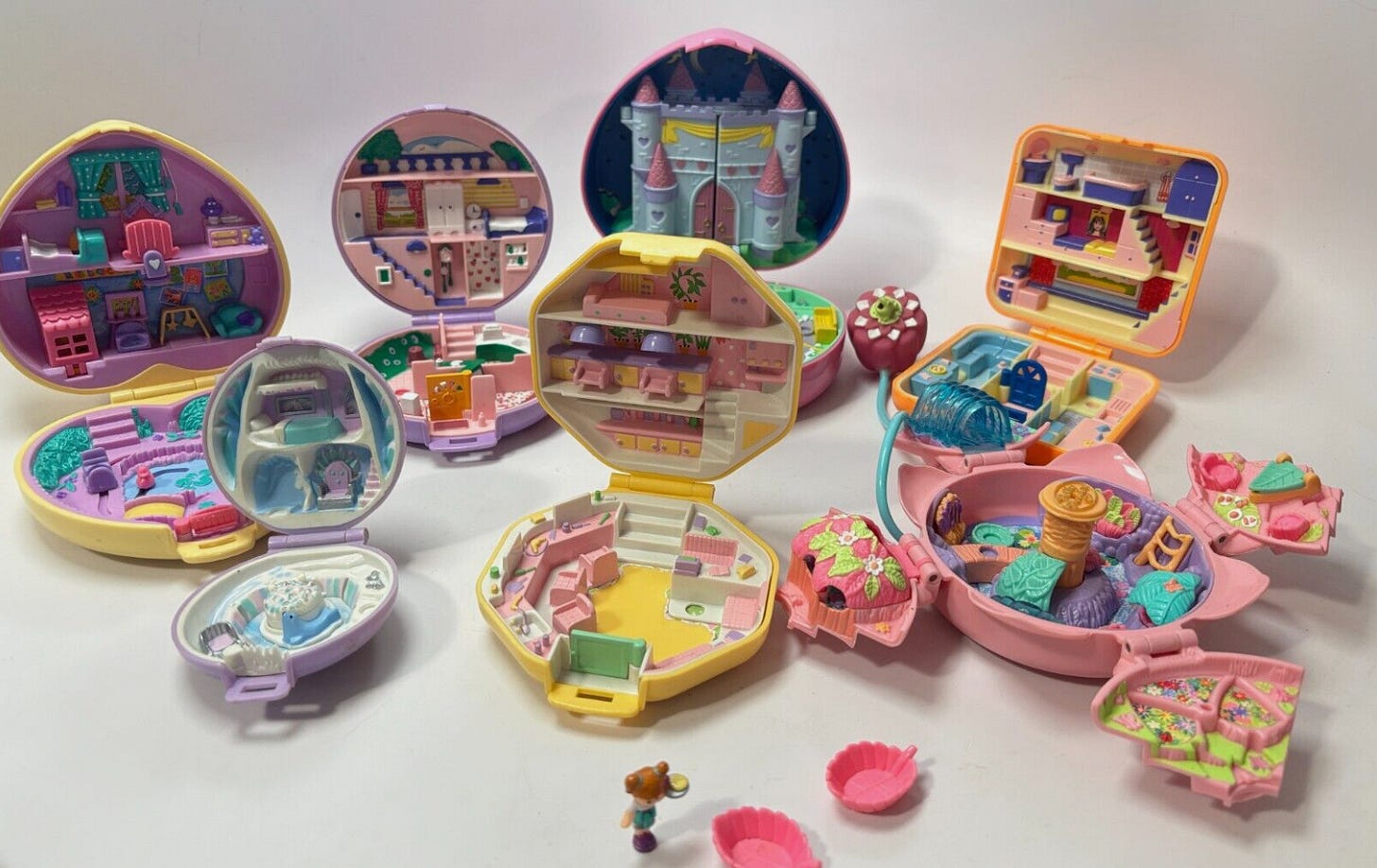Girlhood for Adults: Polly Pocket and Corporate Nostalgia
it's fine, actually, to not dress like your favorite childhood toy
Mattel’s upcoming Polly Pocket movie doesn’t have a release date yet, but it does have a promotional stunt Airbnb.
Lena Dunham dropped out of the project because she didn’t feel like it was a movie that only she could make, but don’t worry—Lily Collins is still expected to star in what will surely be the second-biggest high-budget, live-action flick about an embodied plastic Mattel doll encountering the real world through a series of hijinks and watery women’s empowerment.
We are living in a post-Barbie world where the Polly Pocket movie is about to take hold.
Big news! You are primed for your own regression in a chaotic political moment. Nostalgia is a tool that corporations take advantage of for their own profit and power, and you can’t reclaim something if it further denounces your own agency. I’m ready to write a hit piece on girlhood. Let’s talk about Polly Pocket.
—
Polly Pocket was invented in 1983 by a British man named Chris Wiggs who wanted to create a portable playset for his daughter. He took an empty makeup compact, turned it into a miniature dollhouse, sold the idea to the British toy company Bluebird, and Polly Pocket was available in stores by 1989. Toy-giant Mattel purchased Bluebird in 1998 and changed Polly Pocket’s original design, leading the Bluebird-era sets to become coveted items for ‘90s nostalgics and toy collectors alike.
Bluebird Polly Pocket sets were whimsical worlds cast in candy-colored plastic. The clamshells (shown above) were the most iconic iteration of the playsets. Over 350 distinct clamshell designs were produced, all of which preserved Wiggs’s original design of a self-contained play scene that could be easily closed for compact travel. The dolls included in the sets had big spherical heads, stick-figure-simple facial expressions, and prepubescent bodies that moved with a single hinge at the hip1.
After Mattel’s purchase of Bluebird in 1998, Polly Pocket was redesigned to be bigger in size, older in appearance, and more customizable with removable clothing. Fashion Polly! (shown above) arrived in 1999, introducing the rubbery removable clothing which became a collective childhood chewing sensation.
Polly Pocket had gone from being a portable dollhouse toy to a miniature dress-up toy with the new millennium, and the redesigned product suffered enough losses2 for the toy to be discontinued in the United States in 2012.
In 2018, nearly thirty years after Bluebird’s first Polly Pocket was released, Mattel relaunched the dolls with their clamshell design, albeit with a modern neon upgrade. The sets today are designed around children’s movie collaborations, other Mattel products, and the uniquely terrifying modification of the clamshells themselves being nondescript cartoony animals.

The history of Polly Pocket is a familiar story contained in a particular object: a lovable product with elegant details becomes bastardized with corporate soullessness, leading to nostalgia for when the world (and object) was different.
But it’s too easy to confuse different with better. Was the time of Bluebird Polly Pocket actually better—was the toy?
Polly Pocket’s original clamshells have undeniable charm; they appear to be well-constructed and adorned with more creative details than Mattel’s versions. But I’m interested in Bluebird Polly Pocket clamshells as they’re being repackaged and reframed in the present day. Polly Pocket was always just a plastic child’s toy that reified domesticity and traditional conceptions of femininity—the Bluebird clamshells are special right now because there’s an adult market who remembers playing with them as children.
They’re special because the people who loved Polly Pockets as kids are currently reclaiming girlhood and being sold back their own nostalgia as branded commodity.
—
In her book of critical essays On Longing, poet and scholar Susan Stewart writes that “nostalgia, like any form of narrative, is always ideological: the past it seeks has never existed except as narrative, and hence, always absent, that past continually threatens to reproduce itself as a felt lack.”
The 1990s existed, and Bluebird Polly Pocket existed in the 1990s, but nostalgia for Bluebird Polly Pocket is a narrative constructed around an object; an ideological past living in the material present.
Nostalgia can only ever be based in absence and projected longing—a felt lack.
And what fills this lack? Stuff and ideas, usually. Stuff you can buy, stuff you can wear. Nostalgia can be dangerous because a felt lack desires to be filled, and corporations can appeal to nostalgia with their ideas (“Make America Great Again”) and/or their stuff (Polly Pocket merch). Aesthetics that have been disconnected from temporal reality can be appealed to, warped, and manipulated by powers which act on behalf of their own profit-seeking interests.
It’s never just about Polly Pocket. It’s about filling a yearning for the past through the material present of Polly Pocket. It’s about turning a blind eye to the politics of modern-day feminism because you’re too busy obsessing over nostalgia for the rose-tinted memories of your childhood.
—
In the best-case scenario, girlhood is a project of intersectional feminist reclamation, offering girls and women an opportunity to express and celebrate femininity on their own empowered terms. In my anecdotal experience as a Person on the Internet, girlhood is a tool for privileged adults (often rich, white, thin, and cis, or some combination thereof) to infantilize themselves in an increasingly regressive patriarchal society.
I think Girl Math is BAD FOR WOMEN, and if you think it’s cheeky and cute, I theoretically want to agree, but your “oopsies! lil ol me can’t budget right cuz math not made 4 girlypops cutesy sadface” thing doesn’t happen in a vacuum. I’m sorry. It’s bad for women.
I’m just a girl so I can’t do math! I’m just a girl so I can’t park! I’m just a girl so my girl dinner is an eating disorder!
The relatability of these trends rely on a shared understanding that women are less intelligent and less capable than men, and they reinforce that notion while invoking community. Girlhood-women celebrate their cuteness and smallness; they portray themselves as adorable idiots who derive value from how closely they preserve the mental and physical traits of a child.
Which brings me, finally, to the shirt that made me so upset that I knew a whole essay existed:
It’s a $78 pink baby tee from the Polly Pocket collaboration with Lisa Says Gah that reads “Tiny Vibes”. At the time of posting this, the only size sold out is extra-small. A Polly Pocket x Girlhood x Nostalgia x Lisa Says Gah x Mattel x Misogyny collaboration.
In case you missed it! The American pop-culture politics overview is that women are shrinking, filling out their wrinkles, and losing their rights at breakneck speed. We are living in the painful aftermath of pink-pussy-hat feminism, and Mattel is partnering with San Fransisco-based boutiques to resell ‘90s nostalgia to women in the form of overpriced baby tees that read “Cute as a button” and “Tiny Vibes”.
Mattel loves girlhood—it enables them to sell back their IP to a generation of women that miss the charm of their clamshells in a world that wants women to have as much power as children. Win, win, win! Everyone’s happy! Tiny vibes!
But these messages are fucking dangerous. Women are not girls, they are adults, and for so many women to fashion their own lived experiences through self-infantilization is not radical, especially in our current political landscape, especially especially when that particular evasion tactic is easiest to navigate in the most privileged bodies in our society (white, thin, attractive).
I want to be sympathetic to the “girlhood as reclamation argument”—I can never know someone’s personal history, and who am I to judge? But who, specifically, partakes in the kind of nostalgia that Mattel is selling? What do you stand to gain from its messaging, and what do you stand to lose?
—
In On Longing, Stewart says that “in the final phases of late capitalism, history itself appears as a commodity”. This is the nexus that we find ourselves at today.
As this Polly Pocket movie gets off the ground (and even if it never gets off the ground), you should not mindlessly succumb to every cross-promotional marketing scheme and weaponized nostalgia ploy that “coincidentally” makes it into your feed. You are being sold something, that something has a message, and that message matters.
Women do not benefit from “Tiny Vibes” and “Cute as a Button” trash. You can obviously still buy this stuff, and obviously there are bigger problems than how you-as-an-individual narrativize the power of your own femininity, but insofar as you care about women, you should be invested in their rights and cautious of attempts to make women seem smaller, weaker, and more dependent on their ability to conform to a girlish ideal.
I don’t think nostalgia is inherently bad, but it is definitely not inherently good. Try not to lean on a hypothetically safe, abstractly idealized back then when everything only happens right now. This is not to say that being a toy collector is anti-woman or that buying a baby tee means you’ve failed the suffragettes, but it matters—what we wear, what we do, how we act.
Corporations will always push the ideals of femininity that are most profitable, and no for-profit business in a patriarchal capitalist world cares about inclusive, liberatory change. Listen closely, watch carefully, and try not to get caught up in the pastel dream of a world that only exists in your narrative of an imagined past. We live in the present, so let’s try to stay here, lest we lose our futures too.
If you’re interested in learning more about vintage Polly Pocket sets, Pocket Vintage Toys has an extensive, well-documented collection on her YouTube channel, Only Polly Pocket is an online encyclopedia of all the Bluebird toys organized by year, and Polly Pocket Paralegal is a great eBay resource with well-photographed complete sets. I also enjoyed this Beauty Inside A Box video which details the year-by-year evolution of Polly Pocket.
like the “Quick Clik” magnetic clothes that were recalled after kids started swallowing loose magnets from the pieces











💙tiny vibes💙
Oh so NOW you’re against the miniature
Oooh this is good! I've got an essay in the works on a similar note, think I'm gonna have to cite you as a reference now! ❤️ Amazing work!